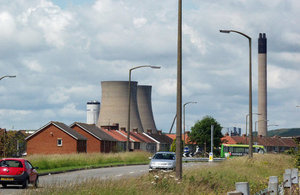Report on state of air quality in England highlights urgent action needed on ammonia emissions
Other findings show that nitrogen oxides and particulate matter have reduced although high levels persist in certain areas

Residential area with colling towers in background
A rise in ammonia emissions is having a damaging effect on wildlife and habitats, according to the Environment Agency’s first ever report on England’s air quality, published today. The report shows that, unlike other main air pollutants, emissions of ammonia have increased since 2013.
Ammonia deposition can overload land and water with nitrogen; it acidifies soils, natural habitats, and freshwaters. These effects reduce biodiversity in sensitive habitats creating a knock-on effect for our wildflower species, aquatic and insect life. The report shows of England’s nitrogen-sensitive habitats, 95% are affected by nitrogen deposition.
The vast majority of UK ammonia emissions, 88%, come from the agricultural sector as a result of such activities as fertiliser use and slurry storage. Higher concentrations and deposition levels are associated with areas of intensive livestock production, especially dairy and beef.
The Environment Agency is today calling on farmers to take urgent action by changing land management practices and becoming more nitrogen efficient. A new Code of Good Agricultural Practice designed in collaboration with farming organisations, DEFRA and the Environment Agency is being published today to help farmers improve their land management and reduce ammonia emissions.
Emma Howard Boyd, Chair of the Environment Agency, said:
Urgent action is needed if we are going to tackle the hidden blight of ammonia emissions. These emissions are having a detrimental impact on the environment, precious habitats and wildlife. As custodians of the land, farmers must take the lead by changing their land management practices.
More broadly, poor air quality is bad for the environment but also people’s health and wellbeing. This report also shows the need to tackle the high levels of nitrogen dioxide, ozone, and particulate matter that persist in certain areas. Improvement to air quality is going to require action from nations, government at a national and local level, organisations, and communities – but just as importantly – individuals.
Huge improvements in air quality since the 1970s
The report shows the progress made in reducing air pollution over recent decades. Since 1970 in the UK:
- Nitrogen oxide (NOx) emissions have reduced by 72%
- Particulate matter (PM10) has reduced by 73%.
- Sulphur Dioxide (SO2 ) has reduced by 97%
- Non-methane volatile organic compounds (NMVOC) have reduced by 66%
These emission come from a range of sources including vehicles emissions and industrial processes. By working with the industries, the Environment Agency has helped to contribute to these reductions and will continue to do so through future regulation.
However, while legal limits are being met for the majority of pollutants, high levels of nitrogen dioxide, ozone and particulate matter remain in many urban areas with high concentrations around homes and schools, and are consequently are a major public health concern. Furthermore, under current projections, emission reduction targets for 2030 will not be met for ammonia, NOx, NMVOCs, SO2 and PM2.5 without further action. Particulate matter can have impacts on health even below current legal thresholds.
The Government has moved to address these issues by publishing its Clean Air Strategy. Clean Air is the first of the ten major goals set in the 25 Year Environment Plan, which contains important commitments aimed at curbing emissions from combustion plants and generators, ending the sale of new conventional petrol and diesel cars and vans by 2040, and improving industrial emissions further by building on existing good practice and the successful regulatory framework. The Clean Air Strategy is currently out for public consultation until mid- August. To comment please go to the Clean Air Stratgey Consultation